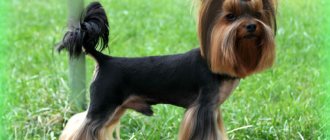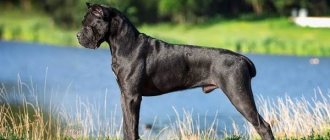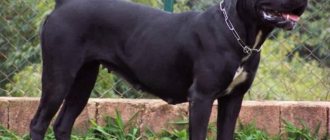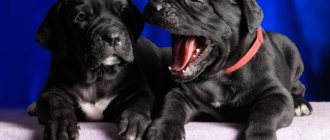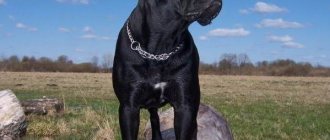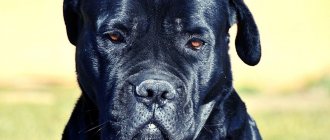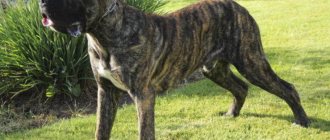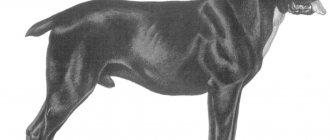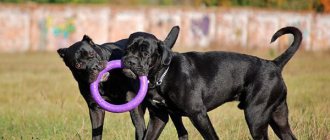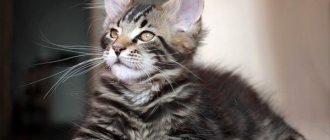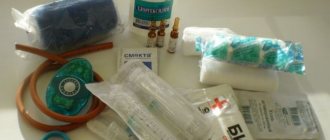Magnificence, courage and dignity are what distinguishes the Cane Corso.
In Italy, the phrase “brave as a Corso” has been used for 800 years.
Modern representatives of this breed are characterized by an antique appearance, which was restored by dog handlers.
The color of the Cane Corso can be different, but black is the most common.
Blue Cane Corso is also called gray, since the tone of this color can vary from light gray (blue) to slate gray or asphalt.
Breed characteristics
| Short description | |
| Origin: | Italy |
| Conditions of detention: | House without garden, house with garden, apartment |
| Purpose: | Guard dog, herding dog |
| Color: | Black, brown, brindle, fawn, black mask acceptable |
| Wool length: | Short |
| Adult dog size: | The height of females is 60-64 cm, males 64-68 cm, weight of males is approximately 45-50 kg, females - 40-45 kg |
| Average life expectancy: | 10-12 years |
| Walk: | Mandatory walk 2 times a day |
| Physical activity needs: | High physical activity needs (regular or daily exercise for more than 3 hours per day) |
| Fédération Cynologique Internationale (FIC) classification: | Group 2: Pinschers and Schnauzers, Molossians, Mountain and Swiss Cattle Dogs; Section 2: Molossians |
| Puppy price: | From 12,000 to 50,000 rubles. Without pedigree – 12,000-15,000 rubles, pet class – 20,000-25,000 rubles, breed class – 30,000-40,000 rubles, show class – 50,000 rubles |
Training and education
Training course required! You should start raising a puppy immediately after purchasing it. Italians are easy to train, but keep in mind that using physical punishment on them is not recommended. The Cane Corso must undergo a general training course and, if necessary, behavioral adjustments. Dogs of this breed are excellent at passing OKD and ZKS due to their endurance and intelligence. Do not forget that the Cane Corso is a serious breed of dog and you take full responsibility for its adequacy and good manners. Cane Corso requires physical and mental exercise, long walking twice a day. If you don’t do this, the dog may chew through all the furniture in the house out of boredom.
Submitting a dog doesn't always work. The principle of complete submission of the Cane Corso to the owner is an outdated method. This theory was formulated based on observations of packs of wild wolves, but they were kept in captivity and, of course, experienced stress. The stress condition forced wolves to show aggression towards each other, but in the wild they do not show aggression to each other - they live together and interact with each other. You need to perceive yourself as the more experienced and mature member of the pack, who is responsible for guiding the new member (Cane Corso puppy) and teaching him good behavior, as well as correcting him if necessary. It is important to remember that Cane Corso puppies learn a lot on their own. They are very inquisitive, love to explore new territories and, of course, experiment. Puppies tend to repeat actions they enjoy (like playing with a toy). They do not repeat actions that cause them pain (for example, destroying a nest and getting bitten). If your Cane Corso puppy misbehaves, ignore him and praise him when he does the right thing. Reward your puppy for following commands and good behavior. Do not neglect these tips. After all, constantly hearing “you can’t” all day long is unbearable. This is a small child who wants to know everything and get his portion of treats as a reward for not eating your favorite rug, going to the toilet outside, bringing you a ball, and so on.
Set rules and monitor their implementation
It is worth enrolling your Cane Corso puppy in obedience training classes. These classes will allow you to understand exactly what actions will allow you to control your dog’s behavior. You will be able to spend more time with your puppy, establish contact and socialize around other dogs.
Adviсe
- Training a Cane Corso puppy should be done with the help of positive motivation; watch carefully special films about this technique. The Canine Translator film series from National Geographic is suitable.
- If you need to leave your puppy at home alone for 2 hours or more, then ask someone to come to him.
- Be sure to make an appointment with your Cane Corso puppy to see the vet as soon as possible. The doctor will carefully examine him and give him vaccinations that will protect him from dangerous diseases.
History of the origin of the species
The Cane Corso is an ancient breed that originates from the Molosser family, the ancient Roman gladiator dogs. The remains of similar animals were found in southern Italy and date back to BC.
In 1238, the coat of arms of the aristocratic family of De Corsi depicted a dog with similar features to the Cane Corso. This image was considered a symbol of masculinity, power, and courage. Although this breed was considered a domestic breed, unsuitable for secular society, its maintenance was honorable. Selection work was carried out randomly, so even in one village there could be individuals of different appearance and character.
The Cane Corso was often described by Italian poets and writers in their works (15-16 centuries). Teofilo Folengo tells of a bear and lion hunt during which Corso was wounded and killed. And during the Renaissance, these dogs were depicted by artists, admiring their muscles and structure. In addition, there are many proverbs associated with this breed.
As for the name, no one knows for sure why pets have this particular name. It is believed that the breed was formed on the island of Corsica, Conrad Gessner wrote about this in his work on “quadrupeds”.
Another version is completely unrelated to the island and the dogs’ habitat. From Latin, Corso is a watchman or guard, and Cane is a dog. From Greek, Corso means property surrounded by a fence . So it turns out, a dog protecting fenced property.
These pets served in all spheres of the peasants' working activities: they herded cattle, drove bulls, hunted, looked after children, and were indispensable in agricultural life. That is why, after the Second World War, during the active phase of industrialization, the number of dogs began to decline.
But Italian enthusiasts, led by Breber, decided to restore the breed line, selecting the most purebred individuals, and received the first standard - the dog Bazira . In 1984, Antonio Morsiani wrote the first breed standard. Cane Corso were recognized recently - in 1994.
Purchase
You can purchase a Cane Corso puppy from both private breeders and specialized nurseries. By choosing option 2, you can minimize the risk of buying a sick, non-purebred pet or one that does not meet the breed standard.
The most popular nurseries:
- Della Valle Dei Tigri, Saratov;
- Celebrity Starlet, Bryansk;
- “Kani Miglori”, Nizhny Novgorod;
- "Corso Granat", St. Petersburg;
- Blow Century UA, Moscow;
- Deo Volente, Moscow;
- Grand Golden Guild, Grodno, Belarus;
- Velvet Black, Minsk, Belarus;
- “Star Treasure”, Minsk, Belarus;
- Be Come The Star Dragon, Odessa, Ukraine;
- Golden Moloss, Kiev, Ukraine;
- Blow Century UA, Kiev, Ukraine.
The cost of a puppy varies depending on its age, health, pedigree, parents' titles and class. So, a pet-class representative can be bought for 13-15 thousand rubles, a breed-class dog will cost 20-25 thousand rubles, and for a show-class puppy you need to pay 35-60 thousand rubles.
Distinctive features
The Cane Corso is a medium-sized dog with well-developed, defined muscles. The format is elongated, the length exceeds the height by 11%. Outwardly he looks strong, graceful, confident. The coat is short, shiny, and lies close to the body.
The last standard was published in 1999. According to it, all dogs that do not meet the standards of behavior and external characteristics are discarded.
- The head is wide, square, small and shallow. Convex cheekbones . The brow ridges and frontal sulcus are visible Characterized by fleshy folds of skin on the forehead and near the lips.
- The muzzle is not long (4/10 of the length of the skull), but wide and voluminous. The bridge of the nose is straight. The jaws are strong, powerful, the upper one is slightly shorter, “undershot” type bite The lips are drooping, the upper one overlaps the lower one and forms an arch. Pigmentation is black.
- The nose is straight, large with open wide nostrils, black.
- The eyes are medium in size, set quite wide and deep (under the overhanging eyebrows). The eyelids are fused at the corners and have bright black pigmentation. The color of the iris is dark, almost black.
- The ears are large, set high, with a wide base. It is customary to cut to an equilateral triangle; otherwise, they hang down on the sides of the head and reach the cheekbones. Covered with short thick hair.
- The body is strong, elongated, with developed muscles. The back is straight and wide, slightly raised towards the neck. The loin is short and strong, slightly arched. The croup is slightly sloping. The chest is wide (35% of the height at the withers), deep (reaches the elbow joint), and protrudes forward. The ribs are rounded. The neck is muscular, equal in length to the head, arched, oval in cross-section. There is no suspension. The belly and hemline are well defined.
- The tail is long (below the hocks), thick at the base, tapered towards the end. Set below the lumbar line, lowered when calm. When active, it does not rise above the croup, but may bend slightly. It is customary to dock at 2/3 of the length.
- The limbs are straight and parallel, perpendicular to the ground, and have a straight posture. The muscles and bones are well developed. Paws are oval (the hind legs are slightly elongated); with fingers clenched into a ball. The pigment of the claws is black. The movements are like a trot, a little stretched out.
- The skin is thick, but fits tightly to the body, forming folds on the head and muzzle.
- The coat is short, flat, thick, lying close to the skin. There is undercoat, but not long (up to 2 cm).
- Colors: black, gray, tan, red, brindle. In red and brindle cats, a black mask is acceptable, and small white spots on the chest, paws or bridge of the nose are also allowed.
SERIOUS DISADVANTAGES/DEFECTS
- The upper longitudinal lines of the skull and muzzle are parallel or converge at too great an angle.
- The zygomatic arches are overdeveloped.
- Partial depigmentation of the nose.
- Scissor bite, overshot more than 5 mm.
- Tail curled into a ring or set vertically.
- Trot alternating with ambling.
- Height above or below the standard.
- Presence of dewclaws.
Photo of an adult dog
DISQUALIFYING FAULTS
- Aggression or cowardice.
- Any dog clearly showing physical or behavioral abnormalities must be disqualified.
- The upper longitudinal lines of the skull and muzzle are divergent.
- Complete depigmentation of the nose.
- The bridge of the nose is arched or humped (mutton nose, Roman nose).
- Underbite.
- Complete or partial depigmentation of the eyelids; whitish eyes (interspersed with blue spots); strabismus.
- Tailless, short tail.
- The coat is semi-long, cropped or fringed.
- All colors not provided for in the standard; large white spots.
Photos of puppies
Features of character and behavior
Cane Corso are true Italians. They are not characterized by strict aristocracy; these dogs are playful, cheerful and active. They are loyal, balanced and reserved. Many people believe that they are to some extent phlegmatic.
These dogs are absolutely not aggressive, but remain good watchdogs and defenders of the territory.
Corsos truly have an impressive appearance and can even strike fear into passers-by and strangers. But these pets feel their strength and will not be able to harm even unintentionally. Most owners have no complaints about the breed, but there are pitfalls everywhere.
Video – Cane Corso with a child:
Advantages
- The qualities of security guards are in Corso's blood. They do not need special training. These dogs have a strong territorial instinct and will protect anything their owners entrust to them. They clearly distinguish between dangerous and safe people and animals, and are not inclined to show aggression and attack first. In addition, they will only give their voice at the most necessary moment, and in an emergency they are able to think and decide independently.
- Infinitely devoted to family. All Cane Corsos are monogamous and will not fawn or play with strangers. Children are not just friends for these dogs. These pets will protect them from any danger, endure all bullying, and will never offend them even unintentionally. Corsos are perfectly aware of their size, so they are quite careful during games. Stranger children are treated no worse.
- They are quite phlegmatic, do not often show emotions, but have bright facial expressions . They are indifferent to animals, they can get along with both a cat and a parrot.
- Smart and obedient, easy to train . They do not strive to take a leading position in the house, and will not manipulate the owners. Corsos are unobtrusive, they will happily play with their household, but will not bother you or get in the way.
Reviews about the Cane Corso dog
Reviews mention positive aspects more often than negative ones . Owners and breeders vying with each other to say that Corso is one of the best family dogs, with whom it is not only not scary, but also cozy.
- Alexandra Zhigun, the owner of the Cane Corso, speaks of her this way: “The best dog in the world, recognized as the best and smartest bodyguard. Agile, friendly, reliable and calm.”
Review from the Cane Corso owner from the dog forum:
Flaws
There are practically no temperamental defects in Cane Corso dogs. But to each his own.
- Definitely, such a pet will not be suitable for those owners who are inactive or do not have the time and financial resources to maintain it. In addition, it is necessary to take into account physiological features, for example, strong salivation and snoring.
- Corsos can be stubborn; girls are often capricious or picky when choosing food . With illiterate upbringing and lack of socialization, a dog can become aggressive towards strangers.
- Without proper physical activity, she will become too active at home . These pets love to try everything “by tooth”, especially in puppyhood.
- It will become a real nightmare for anyone who invades the territory. Corso cannot tolerate strangers who cross the boundaries of a property gate or apartment threshold without permission. There will be no ceremony.
- Indeed, it is rare to find negative reviews about this breed . Most often, a dog brings negative emotions because it does not meet the owners’ expectations (if they wanted a sofa decorative dog) or because of excessive drooling.
One of the owners points out that the breed is wonderful, but without proper socialization it will be wary of everything that moves; also complains of drooling.
Development from 1 to 12 months
| Age | Height at withers, cm | Weight, kg | Description | ||
| Bitch | Male | Bitch | Male | ||
| 2 months | 44 | 32 | 9 | 8,5 | Puppies become independent and do not depend on the bitch. This is the optimal age to buy a puppy - he already has basic skills, he has learned to feed himself, but has not yet formed behavioral habits |
| 3 months | 49 | 42 | 13,5 | 12,5 | The best time to start training is because puppies are inquisitive and flexible. At the same time, their psyche is quite sensitive, so during training you should behave with restraint, do not shout at your pet or physically punish it. First of all, it is necessary for the puppy to remember its name and learn to associate itself with it, after which you can move on to teaching the commands “fu”, “place”, “come to me”, “sit”, “lie down” |
| 4 months | 56 | 47 | 18 | 16,5 | At this age, the puppy already feels confident in the house and begins to show character, claiming the place of leader in the family |
| 5 months | 62 | 55 | 24,5 | 22,5 | Basic commands have been mastered; you just need to repeat them periodically and at the same time include other, more complex commands in your training. Males at this age can show high sexual activity, jumping on other dogs or the owner’s leg |
| 6 months | 64 | 57 | 31,5 | 28 | |
| 7 months | 65 | 58 | 37,5 | 33,5 | At 7 months, Cane Corso can show excessive independence, including ignoring the owner and his commands |
| 8 months | 65,5 | 59 | 40 | 36 | At this age, it is typical for representatives of the breed to experience fear - they can be frightened even by familiar objects or sounds in the house or while walking. It is important that the owner shows restraint and patience and calmly explains to the dog that there is nothing to be afraid of. |
| 9 months | 66 | 59,5 | 42 | 38 | |
| 10 months | 66 | 60 | 44 | 40 | |
| 11 months | 67 | 61 | 45,5 | 41,5 | |
| 1 year | 67 | 63 | 47,5 | 43 | |
All data on the body weight and height of puppies are averaged, so if there is a slight discrepancy with them there is no cause for concern. At the same time, if the dog’s weight significantly exceeds the average, it is necessary to ensure that there are no developmental abnormalities or obesity.
Care and maintenance
The Cane Corso is not a particularly large dog, so it can easily get along in an apartment. Suitable for outdoor keeping only in very warm climates; due to its short coat, it does not tolerate frost well.
The dog practically does not smell, but actively sheds in the off-season. Care, like all mastiffs, includes regular walks, hygiene procedures and proper balanced nutrition.
Before purchasing a puppy, you need to take care of equipping him with a sleeping place. You also need to buy bowls on stands, toys, and hygiene products.
Nutrition
Cane Corsos can be unpretentious in their choice of food, but they can also be capricious. It depends on the personal qualities of each individual. The breed is prone to allergies to certain foods, so it is worth taking seriously the development of a personal diet.
- Cane Corso eat a lot, about 800 grams of food per day.
- Puppies are fed 3-4 times a day, and adults - 2 times.
When feeding naturally, the basis of the diet (50%) should be lean chicken, beef and rabbit meat. In addition, Corso needs to be given sinews and cartilage. The menu should also include other useful substances:
- Cereals (30% of the diet);
- Vegetables and fruits (except potatoes, melons, tomatoes and citrus fruits);
- Eggs;
- Dairy products (kefir, cottage cheese).
If the puppy was fed dry food in the kennel, then the transition should be made gradually or left with dry food. In this case, you should choose only among super-premium holistic products (grain-free).
You should not feed your pet human food, allow him to eat from the table or lick the plates. Clean drinking water should always be freely available. From childhood, vitamins are added to the puppy.
Health
Corsos are original dogs, they developed with virtually no human intervention. But due to various numerous breed lines, they acquired certain diseases that are characteristic of almost all individuals.
Breeders complain about the dogs’ sickness and short life, although according to the Cane Corso standard they can live up to 12 years . These dogs need to be carefully monitored, especially their exercise and diet.
With proper care and timely contact to a veterinary clinic if symptoms of any disease occur, the risk of losing your pet is minimal . Regular vaccination of puppies and adults plays a particularly important role.
Vaccinations
Vaccination of a puppy is the key to its strong immunity and health. The first two vaccinations are usually carried out in a nursery, where a veterinary passport is obtained. All medications are included in the document (name, date).
Every dog requires two basic vaccinations:
- Complex (enteritis, parainfluenza, plague, leptospirosis, salmonella) is done at 1.5, 2, 6, 12 months and annually;
- Anti-rabies (required for taking your pet abroad) at 7 months and every year.
All vaccinations are carried out in special veterinary clinics by trained doctors. Before the second vaccination, walking the pet is prohibited; before the procedure, the dog’s temperature must be measured (even minimal deviations are unacceptable) and disinfected against worms.
Sick pets, pregnant and lactating females, and male dogs after mating are not allowed to be vaccinated.
Diseases
This breed is prone to various diseases of the musculoskeletal system. The worst of them is hip dysplasia; it is inherited and practically incurable. You can prolong and improve the quality of life of your pet with the help of medications; some resort to solving the problem surgically. One way or another, the disease can be avoided if you do not overload the dog’s hind legs.
Often there are problems with the eyes - entropion of the eyelid, cherry eye, conjunctivitis. Diseases of the digestive system, allergic reactions and disorders of the thyroid gland may occur.
Walk
- Walking the Cane Corso should be active, but not very long, especially for puppies. Small dogs are especially susceptible to bone and cartilage disorders. At 3-4 months, pets need to be walked 3-4 times a day for 30 minutes .
- From the age of 4 months, you need to accustom Corse to active walking for 1 hour .
- A good workout would be jogging or swimming . You shouldn’t linger outside if the temperature drops below -5°C or it’s raining. Bad weather conditions will negatively affect your dog's health.
After the second vaccination, you need to accustom the puppy to crowded places so that he can understand that not all strangers and animals are dangerous.
Grooming
The Cane Corso has short hair that does not require special care.
- These dogs shed in the spring and fall, during which time it is important to brush them with a glove brush daily.
- The rest of the time, combing twice with a soft brush is
- Bathing is required when soiled, usually no more than 2 times a year using special cosmetics. You can use dry shampoo or rinse your pet with a hose.
- After taking “baths” in ponds, the dog must be washed with running water .
The Cane Corso's ears the tail . Most often, nurseries do this. The mucous membranes and ears should be inspected for the presence of discharge and debris and wiped with damp cotton swabs 2-3 times a week. Teeth are brushed once a week . Drool must be wiped off after each meal.
In the summer, it is necessary to treat the wool with flea and tick preparations. In addition, it is important not to forget to carry out timely deworming.
Shades of blue Cane Corso
Gray Cane Corso can have different shades - from blue to the color of wet asphalt. In the latter case, this color is called bleached black.
In rare cases, a blue Cane Corso has a light nose, but the eyes are always light.
Cane Corso Formentino puppies are born blue, but with age they become fawn, but the mask remains gray or blue.
Mating
Mating of Cane Corso should take place at 20-22 months of a dog’s life. Puberty comes earlier, at 8-10 months. It is at this time that bitches begin their first heat. By the 20th month, the girl should have her third cycle; 12-15 are considered favorable days for mating, when signs of readiness appear:
- Swollen loop;
- Light bloody discharge;
- Playful behavior.
Corsos are large dogs. For the first time, it is worth inviting a specialist who will help both pets and owners.
The girl is brought to the male, where there should be a lot of free space. The dogs are given 15-20 minutes to get to know each other, after which the female is allowed to mount. The act usually lasts no more than 10 minutes, but pets stand in the castle for a long time ( 30 minutes ). To ensure that the cable does not damage the genitals, it is helped to become comfortable. At this time, the bitch is not allowed to sit down and is supported under the belly.
Repeated mating is organized after 2 days.
What do newborns look like?
Newborn Cane Corso puppies are tiny bundles that experience only basic physiological needs for food, sleep and warmth. They see and hear nothing, they have no teeth and no thermoregulation; of all the senses, only smell is developed - it is by smell that they find their mother. Approximately 12-15 days after birth, the puppies' eyes open, but their vision is still very poor and blurry, and it improves only by 3 weeks of life. At the same time, babies develop hearing and begin to react to sharp sounds.
The weight of newborn puppies is 300-700 g.
Key points in training
You need to start raising Corse as early as possible; from the first days of his life, he needs to be accustomed to a daily routine, an outdoor toilet, walking, and the ability to walk on a leash and without it.
From 4 months you can begin to train intensively. Many dog handlers recommend taking your puppy through the “dog in the city” program, which will teach the pet to live among people, walk in public places and quickly respond to the owner’s commands.
Cane Corsos are not particularly stubborn and do not try to dominate, so they are easy to train and understand people. Such a dog must know the commands:
- "Near";
- "It is forbidden";
- "Sit";
- "Place";
- "Voice";
- "Quiet".
Rough treatment, punishment and harsh methods are not needed; the dog may become offended and withdrawn.
Read about how to properly train a dog in the article: “Training a puppy: effective methods from dog handlers, learning commands at home.”
Health
Cane Corsos are susceptible mainly to hereditary diseases. The most common diseases:
- After purchasing a puppy, you should pay close attention to its diet: it must contain all vitamins and microelements. Cane Corso dogs often have sensitive digestion and a tendency to food allergies.
- Dysplasia of the elbow and hip joints.
- Viral diseases such as plague.
- Inversion and inversion of the eyelid.
- Epilepsy.
- Bloating.
- Umbilical hernia.
Preventative measures to protect your Cane Corso puppy
- To keep your Cane Corso puppy completely safe, you first need to minimize his contact with unfamiliar dogs, especially stray dogs. Therefore, you should not let your dog off the leash, as in this case it will become impossible to control its behavior and communication with other dogs. Since a dog can easily become infected with distemper from simply touching the nose of a sick animal. This disease can be transmitted to a dog through sniffing. Your dog can become infected with trichophytosis from contact with the lichen-affected fur of a sick dog. Naturally, it is impossible to completely exclude a dog’s communication with other dogs, since it must be socialized. Therefore, try to find friends with dog lovers who look after their animals. By adhering to this rule, you can eliminate the risk of pathogen transmission by 80%.
- You should walk your dog in places where there are no landfills. Since garbage very often attracts rodents, which in turn are very often carriers of various infections. Gray rats are especially dangerous because they carry such a serious disease as leptospirosis.
- You should not allow your dog to sniff other people's feces, as they are a source of worms.
- Monitor your Cane Corso's health. Pay attention to even the most minor changes in his behavior. For example, your dog may appear lethargic, lose his appetite, or have a dry nose. Or you may notice that the dog begins to shed, and this has nothing to do with seasonal shedding. If hair loss becomes excessive, this is the first symptom indicating health problems in your pet. And only you can help him. Therefore, it is important to take the dog to the veterinary clinic in time, where the disease can be overcome for sure. In no case should you ignore the symptoms, since advanced infections are much more difficult to treat, and sometimes even impossible. If you start treating your dog, the disease can lead to his death or he will develop serious complications that will affect his hearing, vision, limbs and much more.
How to choose a puppy
The Cane Corso is a prestigious breed, it is very fashionable to keep it, but acquiring a purebred healthy puppy is a big problem. You should only buy a dog from an official breeder, who will present all the documents for the pet, tell you about the litter and breed line, answer questions, and show the parents.
Puppies must meet standards, be active, healthy and happy. The price of such a dog can sting painfully.
For a puppy without a pedigree you will have to pay 12-15 thousand rubles . A descendant of champions, suitable for exhibitions, will cost 50 thousand rubles .
The Cane Corso is a wonderful working and guard dog breed that will serve its family faithfully. She will give all the love to her household and become the best protector for children and adults. But maintaining such a pet will require huge material costs.
5 / 5 ( 1 voice )
Vaccinations
Mother's milk, which puppies are fed in the first weeks after birth, provides their immunity. When the lactation period ends, the babies' protection from infections and diseases disappears. It is replaced by immunity independently developed by the puppies.
| Age | Graft |
| 6-8 weeks | Vaccine against enteritis and hepatitis |
| 8-10 weeks | Revaccination + vaccinations against parvovirus, adenovirus and parainfluenza |
| 2.5-3 months | Vaccination against plague |
| 6-8 months | Rabies vaccine (if a plague vaccination was previously given, rabies vaccination is carried out only at 8 months) |
| 7-8 months | Repeated vaccination against plague |
| 1 year | Vaccination against leptospirosis |
| In the future, vaccinations are repeated annually at the same time. | |
Popular drugs for vaccination are Eurican, Duramune, Nobivac.
Vaccination is not a method of treating a disease, but its causative agent, so it is important that the puppy is absolutely healthy at the time of vaccination.
